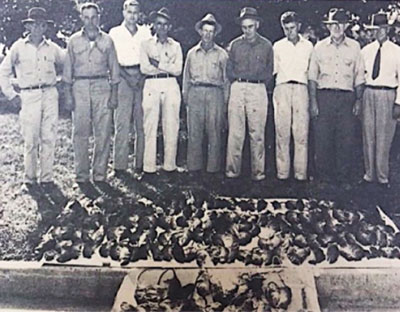
In the 1920s progressive Texans supported by the Federal Agricultural Department and Texas State Health Department began a campaign to eradicate rats from the state. In December 1927, Hunt County joined other Texans in a four-week campaign to kill rats. Local merchants and chambers of commerce in the county offered useful goods to those killing the most.
In mid-December the Greenville Banner reported on the success of the campaign. Reports received from various parts over the County indicated “an appreciable decrease is made in the rat population of Hunt County as a result of the ‘no-quarter’ warfare started two weeks ago by local citizens cooperating with State, County, and Federal authorities. The campaign carried out in this county is expected to result in the deaths of thousands of rodents which have overrun many sections of the county.”
It was believed that children would have more enthusiasm than adults, so kids who caught and killed rats were given a penny per rat. To certify the killing, each child was to chop off the tail of every rat and bring the dead varmint to school as proof.
Each school appointed the newest teacher as Rat Tail Counter. They were dubbed “Rattail” for the rest of the year. But it seems the project was successful here in Hunt County.
Now the worse part of animals and weather and horror of just living occurred in the Texas and Oklahoma Panhandles, the eastern Front Range of Colorado as well as the Dakotas, Kansas and Nebraska in the 1930s. Known as the “Dirty Thirties”, these drought and windstorms forced some to head toward the West Coast where they were not welcomed at all. Others stayed behind on the farming and ranching lands in the High Plains.
Timothy Egan listened to his father’s tales about life in the Great Depression and the Dust Bowl. Egan’s grandmother was a widow who raised four to a bedroom. The book became the source for The Worst Hard Time: The Untold Stories of Those Who Survived, a PBS series created by Ken Burns.
By the time the Dust Bowl arrived in the Central Plains, rats were of no importance. The winds, and dust, and drought had destroyed all food, homes, health, and almost all existence. Egan used oral histories for his award-winning work.
Instead of rats, Dust Bowl persons depended upon rabbits. The worst sandstorm occurred on Black Sunday, April 14, 1935 giving the title of Dirty Thirties to the decade. All produce, livestock, and other food sources were depleted. Rabbits were the sole meat available. At first, they were considered a nuisance, to be driven into a staked enclosure and beaten to death. A means of curing the prey was quickly developed.
The community of Dalhart passed the hat to hire a pilot to fly high enough to dump dry ice on clouds in hope of bringing rain. Didn’t happen. But ironically on Black Sunday in 1935 the sun popped out, weather was mild but with no clouds in the sky, and everyone enjoying life. By mid-afternoon, the sky darkened, sandstorms began with no notice, and the worst hard times came with a vengeance. It was, without a doubt, the worst storm during the Dirty Thirties. However, none were worse.
My grandmothers told of dusting everything in the house twice daily. Both lived near Wichita Falls.
In 1936, President Franklin D. Roosevelt made a campaign stop in Amarillo for his next presidency. While visiting with the crowd, the skies opened up with a lovely slow but delightful rain. It was the end of the Dust Bowl.
